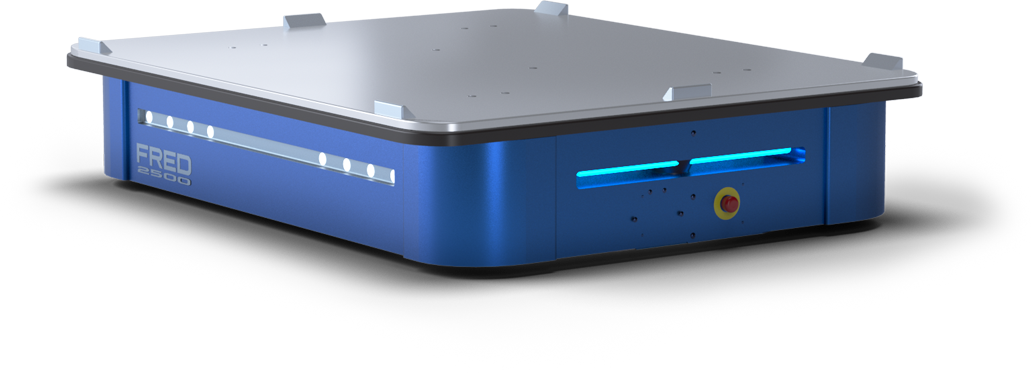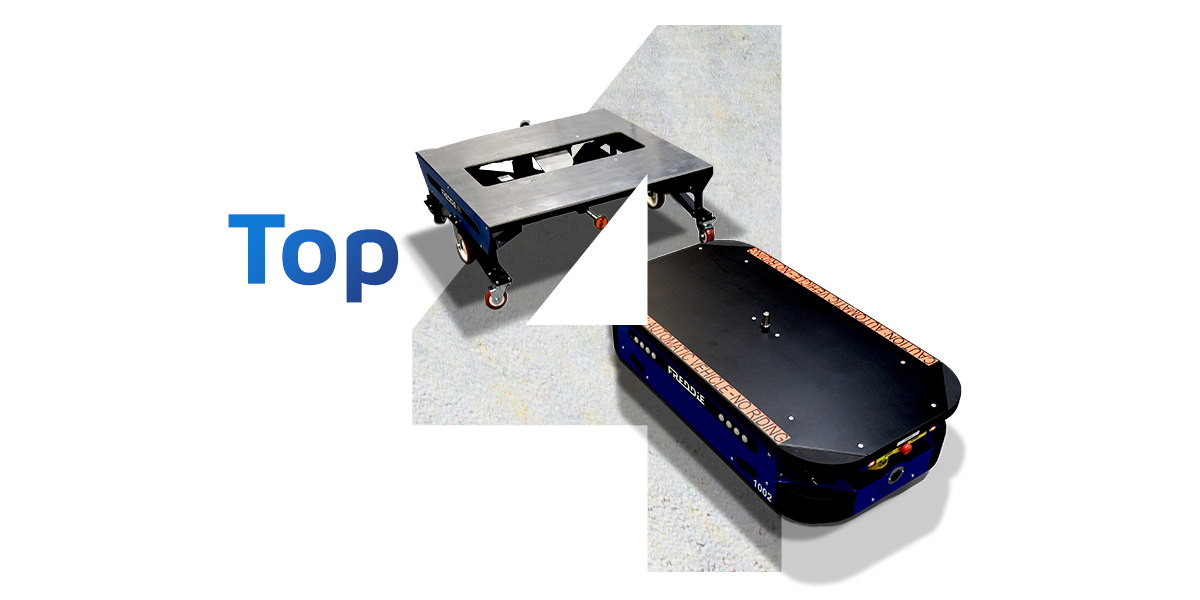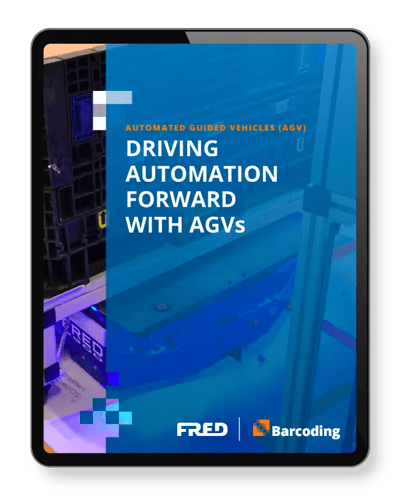Automation has touched—and often transformed—nearly every aspect of our lives. Ideas and technologies barely conceivable at the start of the 21st century are now the norm. Smart thermostats program themselves as they learn our schedules. Our speakers don’t just play music. They listen to us, set alarms and reminders, create shopping lists…and speak back to us. We no longer just flip a light switch at bedtime. We create an automated “scene” that triggers when we leave our home, turning our lights off and security system on. We no longer manage our calendars. They efficiently manage us.
Whenever we can get more done with less input—and in less time—we’re enjoying the benefits of automation. Industrial automation is no different. And getting more done in less time and with fewer resources is why it’s become so attractive to warehouses and factories around the world. Unlike everyday personal automation, however, industrial automation has been available for some time. Perhaps the most well-known example is the now-familiar assembly line. Introduced by Ford Motor Company at the start of the 20th century, it allowed the company to produce eight cars in the time it took other manufacturers to produce just one. Ford’s investment into automation earned huge returns.
Today’s industrial automation, of course, is far more advanced than Ford’s was. And it has the potential to deliver even greater returns. But until fairly recently, many automations that drive the highest productive efficiencies remained inaccessible to most due to costs of implementation. Unless your company was running a massive national or multinational operation, the ROIs simply didn’t add up.
That’s all changed now. Technology has become more sophisticated. Adoption has increased as prices have decreased. Today, even small- and medium-sized companies can automate their industrial workflows. What’s more, they can do it in more ways than ever before.
Following is a list of some of the top automation technologies—with a focus on robotics—that companies of all sizes are using to streamline their operations. Not every one of these technologies will be right for every warehouse, factory or business circumstance. But adding just one or two to an otherwise manual workflow can help you reap tremendous returns on your investment—and put you in a more competitive position than ever before.
1. Automated Vehicles
Industrial automated vehicles come in many shapes, sizes and capabilities. But they generally fall into three main categories (with occasional overlap in functionality):
- AGVs (Automated Guided Vehicles)
- AGCs (Automated Guided Carts)
- AMRs (Autonomous Mobile Robots)
AGVs
The most common among them is the AGV, of which ASI manufactures two models, FRED and FREDDiE. And even among AGVs, you’ll find various form factors suitable for different tasks and environments. The three most common are Unit Load Vehicles, Tuggers/Towers and Forklift AGVs.
- Unit Load AGV: Unit Load AGVs are equipped with a deck, and are typically used to transport either single loads (e.g., a heavy or unwieldy part, like an engine or windscreen) or unitized pallets. They can also be equipped with conveyors, lifts, shelves or other customizations to meet your specific needs.
ASI’s FRED and FREDDiE are both Unit Load AGVs. FREDDiE, a medium-duty AGV, can carry a unitized load of up to 400 pounds. FRED, the heavy-duty model, can carry up to 2,500 pounds on its deck. And here is where we come to our first overlap in functionality. FRED works double duty as a tugger, too, and can tow up to 5,000 pounds. - Tugger/Tower AGV: A Tugger AGV (also called a Tower AGV), pulls one or more non-motorized carts or trailers behind it. This was the first type of AGV to be introduced to factory and warehouse environments, and remains popular today.
- Forklift AGV: Also known as a fork truck AGV, this type of vehicle can fully replace a forklift and driver because it can move loads both vertically and horizontally. While very capable, forklift AGVs can also be very expensive.
AGCs
An AGC is a very close cousin to the AGV. They tend to be lighter duty, and are typically designed to move either a fixed or removable cart. In fact, because AGCs are so similar in functionality to AGVs, you may often hear the terms used interchangeably. And this is also where we come to our next overlap in functionality: FREDDiE, designed as an AGV, also effectively works as an AGC.
AMRs
Depending on how it’s been designed, an AMR performs exactly the same function as either an AGV or AGC. The only significant difference is its navigation technology. Whereas AGVs or AGCs require physical modifications to an environment in order to navigate (e.g., FRED follows a strip of easily laid magnetic tape), AMRs use what is known as “natural” or “free” navigation.
The easiest way to consider the differences between AGVs and AMRs is by comparing them to trains and self-driving cars. An AGV follows a predefined path from which it will not deviate (just as a train follows tracks). An AMR—while still typically following a predefined path—can deviate should the need arise (just as a self-driving car may navigate around an unexpected obstacle).
In practice, the difference is subtle. Should a person or other obstacle block an AGV’s path, it will come to a stop and wait for its path to be cleared before resuming. An AMR in the same situation may instead attempt to navigate around the person or obstacle.
Why Choose an AGV over an AMR?
aCost of implementation. The guidance technologies AMRs use (SLAM) are expensive—and require a great deal of software, connectivity and personnel training to work effectively. For example, when receiving a quote from an AMR vendor, you may find it not only includes software but also options to purchase training hours and service contracts. An AGV like FRED, by contrast, requires none of those. You can set up FRED in under two hours after following instructions that fit on a single piece of paper.
In essence, the choice between the two comes down to ROI. FRED—an AGV—can pay for itself in just four months and save its owner over $100,000 per year. A similarly capable AMR, meanwhile, might cost as much or more than FRED saves in a single year.
2. Automated Storage and Retrieval Systems
Inventory storage and retrieval is often a predictable and repetitive task. And while necessary, it rarely makes for good use of your human resources. An automated storage and retrieval systems (AS/RS) automatically places and retrieves loads from a defined location. What’s the benefit?
An example would be order picking at a distribution or fulfillment center. When humans take on this role, they can spend nearly half their time walking and manually picking goods from an inventory. An AS/RS, however, can keep the human in place and bring the goods to them. This is often called Goods-to-Person (G2P/GTP) order picking.
Like many other industrial automations, AS/RSs were once too cost prohibitive for smaller warehouse operations. But as technology has advanced, prices have come down, putting an AS/RS within reach of many SMEs. This is not to say they’re cheap—the smallest and least expensive might run $80,000. But, just as with other automations, they’re an investment that returns time, productivity and, ultimately, money.
3. End-of-Line Automation
End-of-line (EOL) packaging automations—next to AGVs—deliver some of the most productivity enhancing returns of any other type of industrial automation. The most common among them are palletizers, stretch wrappers and pallet dispensers.
Palletizers
Perhaps the most widespread use of EOL automation is found in robotic palletizers, those iconic multi-axis arms many of us picture when we imagine industrial automation. These mechanical manipulators have been building (and deconstructing, for non-EOL processes) tidy pallets for almost half a century. And like AGVs, both the financial and technological barriers to entry are lower than they’ve ever been.
Many warehouses or factories will already have a conventional automatic palletizer in place. These machines—while often quick and dependable—are more limited in their capabilities and larger than they’re more advanced robotic siblings.
A conventional automatic palletizer can typically handle just one SKU, product type and stacking pattern at a time. A robotic palletizer, meanwhile, can often handle multiple SKUs and product types, and adjust its stacking pattern accordingly. This increase in flexibility allows for mixed-case palletizing—and getting more product out the door sooner.
Stretch Wrappers
After your robotic palletizer builds you a tidy pallet, you’ll want it to stay that way. Enter semi-automatic and automatic stretch wrappers. Stretch wrappers are available in four primary categories: turntable, orbital, rotary arm and rotary ring. But the more important distinction to make—and you’ll soon see why—is between semi-automatic and automatic wrappers.
Semi-automatic wrappers must be fed manually, often by a human driving a stacked pallet over on a forklift. Automatic variants have some means of feeding stacked pallets into their wrapping mechanisms, typically by conveyor.
But…an AGV can effectively turn a semi-automatic wrapper into an automatic wrapper. To demonstrate, we’ll use FRED as our example AGV. Loaded with a unitized pallet, FRED would drive onto the platform of a turntable-style wrapper. The platform spins both FRED and the pallet, securing the unit. FRED, now carrying a tightly unitized pallet, then drives off the platform and on to its next destination.
This increased degree of productive efficiency for a semi-automatic stretch wrapper only took the addition of an AGV. Taking that into consideration, you may have a great reason to invest in an AGV before an automatic stretch wrapper.
Pallet Dispensers
Automatic pallet dispensers, also known as pallet feeders, save space, time and, like other industrial automations, human-capital resources. And they do exactly what their name implies: they dispense empty pallets (and often stack them after being fed, as well). This saves space because 15 or more pallets can be kept in a tight vertical formation, which frees up real estate for more productive uses. And it saves time—and, in turn, human-capital resources—because what was once a manual process has now been automated. Why tie up your precious human capital dispensing or stacking pallets when a machine can do it more efficiently?
In the past, a dispenser might have fed a pallet onto a forklift or heavy-duty conveyor. Either one of these machines would then take the pallet to its destination—perhaps an automatic or robotic palletizer.
Today, pallet dispensers operate in much the same way. But, rather than feed a pallet onto a forklift or conveyor, they might instead drop one on the deck of an AGV. This AGV would then continue on its way to its next destination. Similar to our previous example of the AGV working alongside the palletizer, this type of collaboration demonstrates our next top automation technology…
4. Cobots
To some degree, each of the industrial automation technologies we’ve mentioned thus far are cobots. But cobots aren’t necessarily a category of automation equipment so much as they are a philosophy of industrial automation.
Cobots are simply robots that collaborate/cooperate with humans. In most applications, the cobot and human share the same space (e.g., a warehouse or factory floor), but perform different tasks, either independently or in sequence. And it makes for some incredibly efficient and productive workflows. An example would be a human forklift driver feeding a palletizer an unorganized load of boxes.
But where industrial automation becomes even more powerful is when robots collaborate with each other. We’ve already covered two examples of robot-robot collaboration: an AGV driving onto the platform of a rotary stretch wrapper, and a pallet dispenser feeding an empty pallet onto an AGV’s deck. The efficiencies needn’t end there, though.
An AGV can feed product to a robotic palletizer. And a robotic palletizer can build a palletized unit on top of an AGV.
Checkweighers are typically found on the factory floor of manufacturers of smaller goods. Their purpose is to verify quantity counts by weight. An AGV fitted with a conveyor on its deck can distribute product onto a checkweigher. Once the checkweigher verifies quantity, it transfers the product back to the AGV. The AGV then moves on to its next stop—perhaps the previously mentioned robotic palletizer.
Robots working alongside humans—and especially alongside each other—deliver an entirely new degree of productive efficiency. And as much as any single automation technology drives ROI and bottom lines, several working in sequence compound the effect.
Where to Start?
We’ve just run through four automation technologies, each of which can make any factory or warehouse more productive. So, where should you start?
Your first instinct might be to install cobots everywhere. And you’d not be wrong to think that. By all indications, cobots are the wave of the future—not just those that work alongside humans, but those that work alongside each other. Lights-out manufacturing. Industry 4.0. More and more, we’re moving toward automated solutions that increase safety, productivity and efficiency.
But fully automating your environment doesn’t have to happen all at once. For one thing, it would be prohibitively expensive—not to mention disruptive to your operations. It takes more than the flick of a switch to go from “lights on” to “lights out.”
What makes more sense for the majority of warehouses and factories is to start small, and then build out automated processes from there. Essentially, start with a technology that will play well with others as you grow. This way, you can be certain automation fits into your warehouse or factory environment and delivers the productive efficiencies you desire. You’ll also not have to worry about retraining your employees to manage wholly new workflows.
For most warehouses and factories, an affordable—and capable—AGV would be the smartest first step toward automated workflows. As we’ve seen, they can already bring automation to non-automated equipment like stretch wrappers. What’s more, they work well alongside both humans and machines. Because AGVs have been designed to augment and replace the traditional, non-stationary human-forklift combination, you can be fairly certain that any automation technologies you later add will be designed to work well alongside your AGV.
So, start with the right AGV . You’ll have the opportunity to earn a blazingly fast ROI. You’ll be more competitive in the market as you leverage new productive efficiencies. And you’ll be ready for more collaborative automation when the time is right.
Automation Questions?
Businesses across many industries are now turning to automation technologies as powerful solutions to once unforeseeable material-movement challenges. We’re here to help you navigate the automation landscape, and drive your business forward. To learn more about how FRED and FREDDiE provide easy-to-implement solutions to complex challenges, contact an ASI Automation specialist today at info@fredagv.com.


